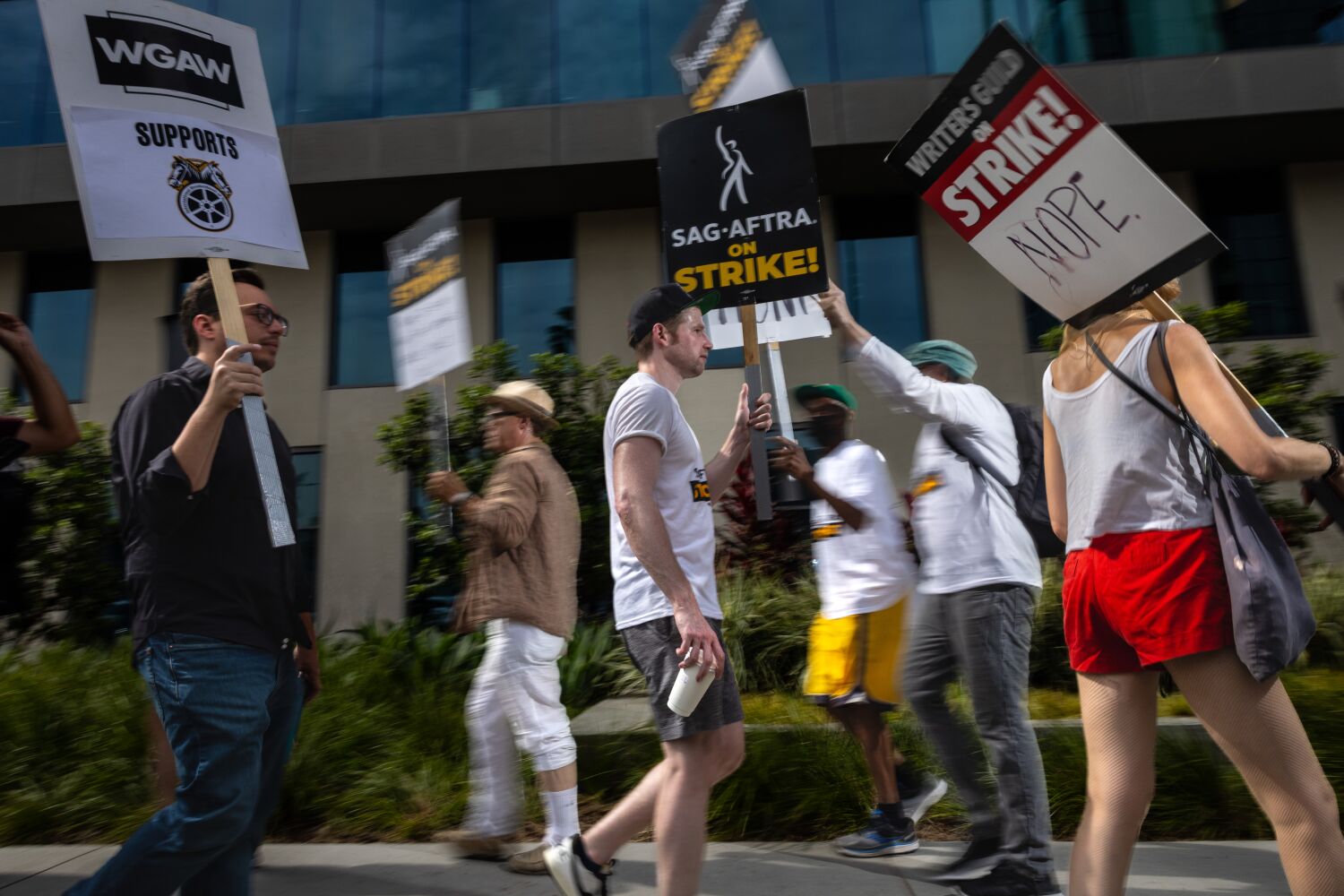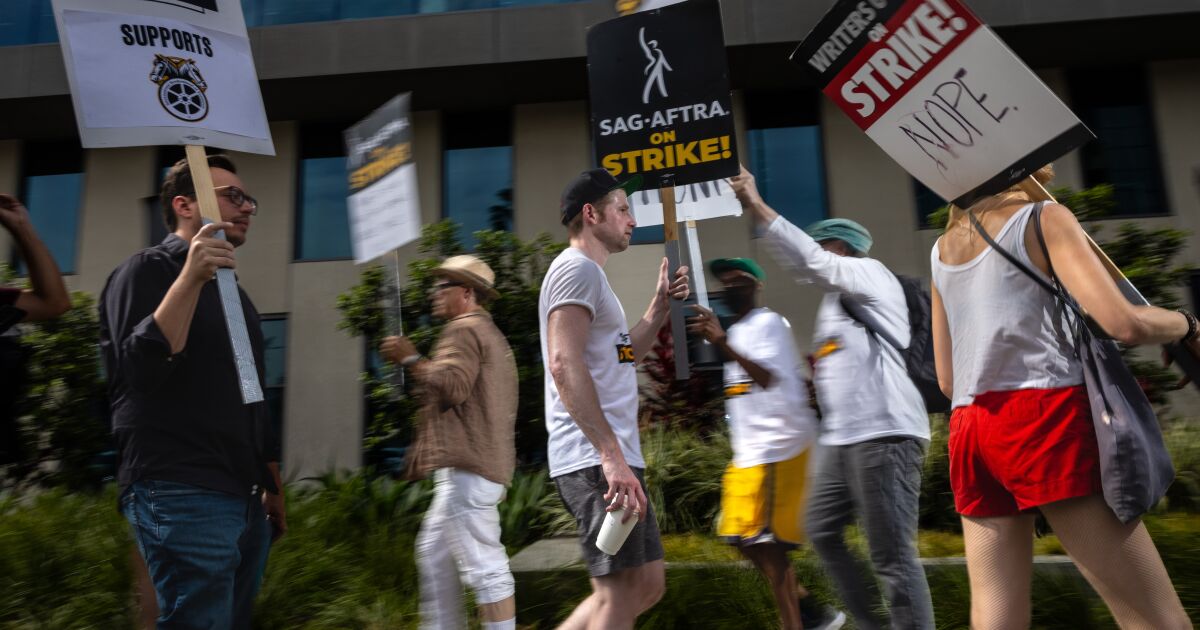
It’s hot, sweaty, and built on solidarity: Los Angeles has become a picket city this summer, with more than 100,000 workers on strike in the area.
Each group of workers—screenwriters, actors, hotel staff, city employees, and more—is fighting its own battle, but organized workers are having a moment on the streets of Los Angeles.
“There’s a perception that we have so little in common, but we’re fighting for our future,” playwright Sam Chance said recently, as she walked in a picket line alongside hotel workers.
But is this hot summer just a perfect storm of regulation, economics, and the end of the decade? Or is this the new normal?
Strike activity in the United States has quadrupled since last year, and Los Angeles is the stoppage capital for 2023, largely due to the huge number of Los Angeles-area writers and actors represented by the WGA and SAG-AFTRA unions.
Nationally, however, this level of labor action is a return to pre-pandemic form. More than 400,000 workers went on strike in both 2018 And 2019, which saw the “Red for Ed” landmark strike and a major General Motors strike. This year’s sit-down population has passed 300,000 so far – but it still has time to break the latest record, if about 150,000 workers at the Big Three automakers go on strike after their contracts expire in September.
On a longer time scale, the past decade has seen much less manufacturing activity than most decades of the 20th century, when union membership was much higher across the US, and despite a wave of new union organizing at companies like Starbucks and Amazon, has had a hard time haggling over contracts. The first is repelling the anti-union tactics of employers.
However, it’s hard to deny that something is in the air this season. Johnny Callas, PhD student at Cornell University and directing Cornell-ILR Work Job Trackerwhich monitors work procedures nationwide, points to the epidemic as a direct cause.
“For a lot of these workers, this is the first contract they’ve been negotiating since the beginning of the pandemic,” Klass said.
Meanwhile, the cost of living has risen, which means record increases still equate to wage cuts; Corporate earnings have been on the rise across the economy since 2020; Unemployment remained low, giving workers more bargaining power.
This powerful combination of factors made the workers ready to fight, Klass said.
“The pandemic has had the effect of delegitimizing management in every way,” said Nelson Lichtenstein, who teaches labor history at the University of California, Santa Barbara.
Especially in the early days of the pandemic, Lichtenstein said, “managers lost credibility whether they tried to do the right thing or not.” Office staff knew they could have been working from home all along, even before lockdown rules made it necessary. Essential workers, who had to report to work in person, learned that their health was less important than the bottom line.
Then, as the COVID-19 recession turned into a stock market boom, rising prices wiped out the spending power of the average employee while many of the companies they worked for reported solid earnings.
“The companies were discredited,” Lichtenstein said, “and that was very intimate. It was nothing like Madoff or the big banks doing something. He was right there in everyone’s face.”
Los Angeles in particular is at the forefront of two trends: increasingly expensive housing and a growing amount of union solidarity.
The Unite Here Local union representing striking workers at dozens of hotels across the region has linked its demands to the negotiating table with housing issues. In negotiations, the union asked hotel owners to charge customers new fees that would feed a fund to help workers get affordable housing and support a 2024 ballot measure that would require Los Angeles hotels to rent vacant rooms to unaccommodated people.
And the decades-old erosion of regular residual payments and employment in supply has put housing costs front and center for striking writers and actors.
Even a group representing local businesses agrees that housing costs contribute to labor unrest.
Maria Salinas, president of the Los Angeles Area Chamber of Commerce, said her group is “very interested in issues of affordability, particularly in housing” and that it They advocate for organizational changes To increase housing construction.
According to a recent informal survey of about 100 CEOs, Salinas said, “the number one issue was housing affordability, followed by labor market tightness,” both of which make it difficult to recruit and keep workers in Los Angeles.
Kent Wong, director of the UCLA Job Center, noted that housing costs also spurred a statewide graduate student strike last year, with workers having “enormous difficulty making ends meet, especially given the high cost of housing.” “.
“Another major factor is that Los Angeles is an important focal point for the new American labor movement,” said Wong. Since Miguel Contreras assumed leadership of the Los Angeles County Federation of Labor in the mid-1990s, the local labor movement has been at the forefront of organizing immigrant workers, non-union workers, and youth workers across industries to push for political change, such as raising the minimum wage to $15 an hour and beyond.
The labor movement in Los Angeles is coming together more than it has in years past. In March, L.A. school teachers represented by United Teachers of Los Angeles coordinated a joint three-day strike with L.A. school workers represented by SEIU Local 99. Within weeks of joint action, the two unions struck contracts with significant raises— 21% for teachers And 30% for employees Represented by SEIU. This year also marks the first time since 1960 that screenwriters and actors have gone on strike simultaneously, and the local Teamsters have stuck to honoring their picket lines.
But even so, organized labor in the United States is relatively weak compared to previous decades—efforts to organize new groups of workers into unionized contracts have met stiff opposition from employers.
“Usually when you think about the moments of mobilization and discrediting of the old regime, from the 1930s to the 1960s and 1970s, the organization expands,” Lichtenstein said. “But that is not happening now.”
To explain the gap, Liechtenstein points to weaker labor laws and management hostility.
“The administration’s strategy now is basically not to recognize the union and wait for it, even if it suffers a blow to its reputation, and that often works,” Lichtenstein said. “The guide works, given the current state of labor laws,” which impose small penalties on employers for violations and have little power to force employers to the negotiating table.
“In this country, management is very against the idea of unions and collective bargaining, even when it is in their interest or leads to good results,” said Klass, a researcher at Cornell University. Starbucks workers, for example, have unionized at more than 300 coffee shops, but the company has made it through. intense campaign To avoid acknowledging them or compromising the first contract.
But if hard management tactics continue to hit the workforce losing purchasing power, losing homes and losing patience, workers can continue to organize and resort to strikes when negotiations break down.
Wong said the summer strikes are a reflection of “a growing awareness of workers and a reflection of deep dissatisfaction with the status quo that is not working for most workers.”
Wong added that the economic inequality in California grown during the epidemic Although the state government was ostensibly made up pro-Labour. “More workers see the need to organize, mobilize and fight for better wages and conditions in the workplace.”
